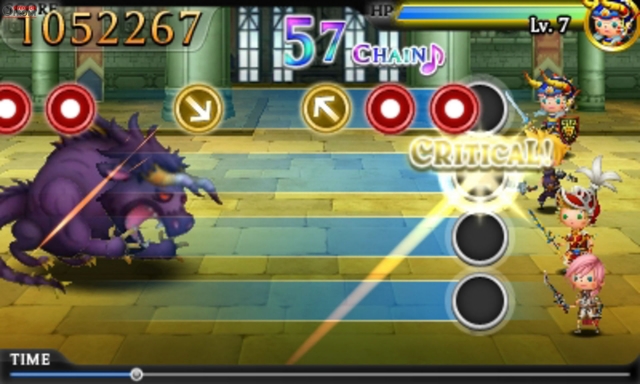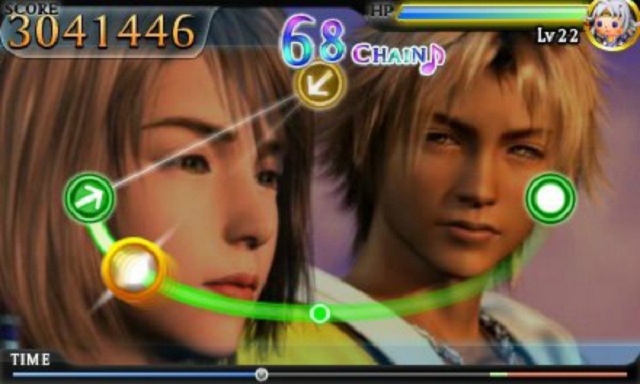Theatrhythm: Final Fantasy is probably one of the oddest turns the series has taken. It’s no Mega Man Soccer, but it’s still strange territory. Just the same, I’m wondering why they didn’t do anything like this sooner. The Final Fantasy games are all filled with powerful, evocative pieces of music, and there are decades of it. The idea of playing a rhythm game with the sweeping songs I grew up with made this an instant purchase for me, and it was well worth it. It’s fun, and it’s as good an excuse as any to go back and listen to some of the most defining moments in game music history.
Theatrhythm: Final Fantasy is a pretty robust look at Final Fantasy‘s history. It pulls tracks from every game in the main series, stopping at Final Fantasy XIII. There are only a handful from each game to start you off in the basic music player, with each game getting five tracks. You get the opening and ending music, the world theme, a battle song, and typically one other important track from the game to keep you busy. It’s something that doesn’t seem like a lot of music on paper, but when you start playing these songs, you’ll realize that this is still a good couple of hours worth of gameplay.
Playing these songs is pretty straightforward. The whole game is controlled with the stylus, requiring you to either tap, hold, or sweep it across the screen. If you’ve seen screenshots from the game, you’ve probably seen four rows of symbols shooting across the screen at the specific characters and worried that the game is going to be picky about where you tap. Luckily, you can tap anywhere and it will hit the symbol. Just make sure it’s in your character’s hit window when you tap, and everything should be fine.
The game is divided into three different play types: travel, battle, and cutscene. Cutscene is the least interesting, with your hit circle moving around while a scene plays in the background. With travel, the amount of critical hits moves you further along a little map, and gaining more distance means you’re that much more likely to run into a moogle and get a free item. If you go really far, a character from that game will also show up to give you something, so it encourages you to play well to get cool stuff. I’ll touch on what you can get in a bit.
I liked the battle sequences best of all. In those, your score is channelled into damage dealt to monsters, encouraging you to play as perfectly as possible. Play well and you’ll kill more monsters, making it more likely that you’ll pick up some loot when you finish the battle. Also, the battle music is easily some of the best in the series, and makes those sequences much more exciting than the others. These songs tend to be a lot more intricate and fast-paced, so they tend to have more complex patterns that make them that much more difficult.
How can there be loot in a music game, though? Well, you can collect a lot of silly items as you play, such as cards and gems that help unlock characters. Those are nice, if only because they give you a reason to keep playing the same area over and over. On top of that, you can also get items that will help you when playing the songs. For instance, there are a handful of items that deal a bit of damage to monsters if you pull off a set amount of hits in a row, or ones that add a little bit of health after yours drops to a certain level.
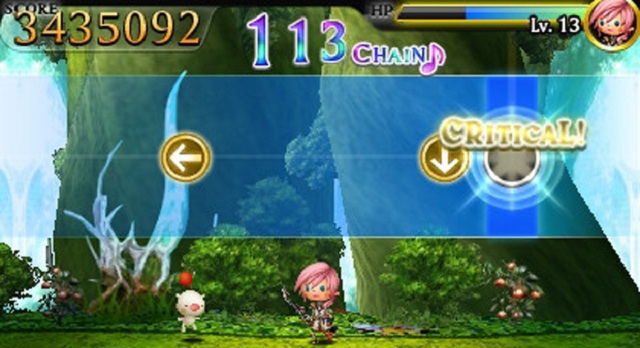 Speaking of levels, your characters can level up as well, gaining more hit points (HP), better stats, and new powers. Having high HP never hurts, as it keeps you in the songs when you screw up. Other stats affect how much damage you do during the battle songs, and a few other stats affect travelling and cutscene performance. You can also equip powers that have similar effects to items, allowing you to use them during every fight.
Speaking of levels, your characters can level up as well, gaining more hit points (HP), better stats, and new powers. Having high HP never hurts, as it keeps you in the songs when you screw up. Other stats affect how much damage you do during the battle songs, and a few other stats affect travelling and cutscene performance. You can also equip powers that have similar effects to items, allowing you to use them during every fight.
This might seem like handy stuff, but you might not notice on your first run through the basic songs. As much fun as it is, the basic levels aren’t challenging in the slightest. You’ll never need better powers or more HP, since there’s rarely much to do in the basic songs. You’re never pushed to do anything other than lazily tap the screen for a good couple of hours, which made them relaxing. It was kind of nice to just listen to the music without having to put in much effort, but it was also a little boring.
Just the same, the game gets a lot more fun when you unlock the Chaos Shrine and expert level versions of the songs. These two modes are challenging, forcing you to move at a pace that I was completely unprepared for when I first tried them. Unlike other rhythm games, which tend to push you toward a plateau in skill that puts you right in line to learn the next difficulty level, Theatrhythm: Final Fantasy just drives difficulty through the ceiling once you unlock these areas. They are doable, don’t get me wrong, but I would have liked to see some more progression in the basic game. As it stands, the challenge is a flat line for a good few hours, suited for someone who wants to goof off with it, but nothing more.
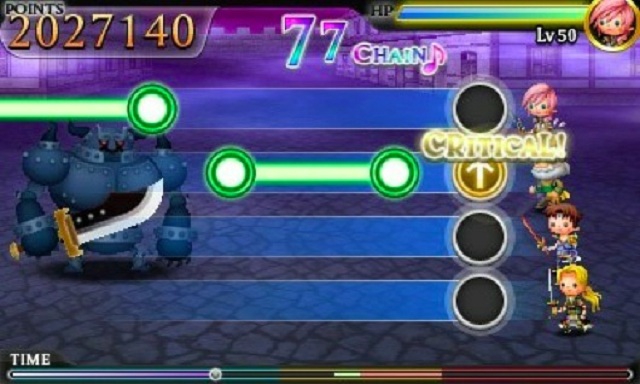
It’s a shame that the game takes such a long time to find its feet, since it really takes off once you unlock those modes. The boredom that infected a lot of my first few hours was blasted away by the more challenging levels, and I soon found that the game dragged me in hard. I would play for hours trying to get better scores and better items, often having to claw my way to the end of a song. It made a lot of the music so much more invigorating, and I found it captured the spirit of the music better. After all, no one should be feeling calm when “Battle for Big Bridge” or “Dancing Mad” are playing.
I just wish that I could see the visuals in the game while I’m frantically trying not to die, though. This game has its own visual style; each of the characters almost looks like a button-eyed doll. Even the enemies have a patchwork look to them that’s almost reminiscent of Little Big Planet, but not quite. Patchwork doesn’t quite describe how it looks, but take a peek at some of the screenshots and you’ll see what I mean. I really liked it, especially when I got to see a cutesy-looking Kefka come on my screen.
Those visuals lose a little bit of effect when you realize you won’t be looking at them much. The shame is that you’re caught up watching the symbols pass by and thinking about when to tap the screen when all of these amazing visuals are passing you by. Cutscenes from past games will play out before your eyes, and you won’t even notice them. The new visual style is something you’ll only catch in passing during lulls in the action. I love the artwork, and I think it brings a lot of appeal to the game, but you just won’t get to see much of it. It’s a shame, to the point of me wanting to watch someone else play it just so I can get a better look at it.
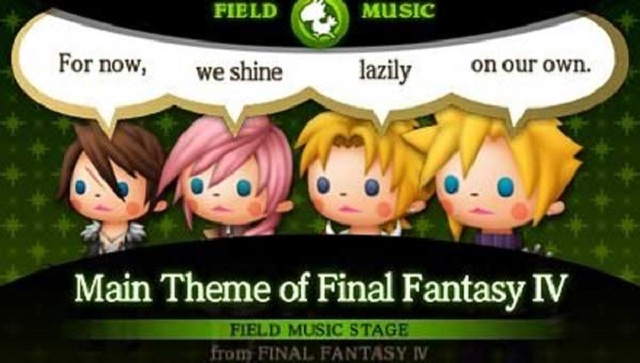 Despite its flaws, I really had a good time with this game. The difficulty spike is a rough spot in the game, but after a few losses, you might surprise yourself with how quickly you adapt. Once you hit that point, the game really opens up to you with challenging songs to play. It may take some time to get the game to a point where it is a decent challenge, but it’s worth putting the time in. All the levelling and item-collecting that seemed so pointless before will become useful, and then the game gets really interesting. Also, with its reams of collectibles, you’ll always be unlocking something different to play around with.
Despite its flaws, I really had a good time with this game. The difficulty spike is a rough spot in the game, but after a few losses, you might surprise yourself with how quickly you adapt. Once you hit that point, the game really opens up to you with challenging songs to play. It may take some time to get the game to a point where it is a decent challenge, but it’s worth putting the time in. All the levelling and item-collecting that seemed so pointless before will become useful, and then the game gets really interesting. Also, with its reams of collectibles, you’ll always be unlocking something different to play around with.
It doesn’t hurt that this game is a collection of the best music in video game history. Playing through this game took me back to some of my favorite gaming memories, and has given me the itch to boot these games back up again. Combining that with the recent discovery of a new glitch for Final Fantasy VI that makes General Leo a playable character, and it’s a really great time to be a Final Fantasy fan. If you like game music and rhythm games at all, it’s well worth your time.
Images courtesy of gamrreview.com, g4tv.com, 3dsbuzz.com, joystiq.com, gamingunion.net


